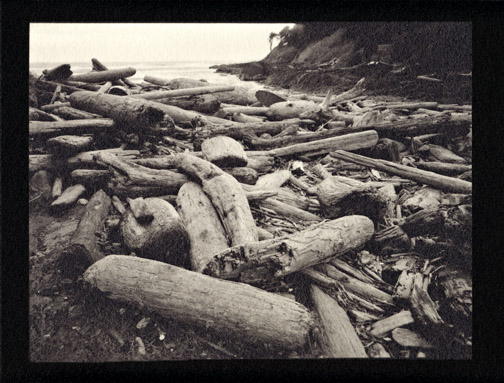Dissolve NaCl in water – set at room temp.
Dissolve AgNO3 in water – warm to 40C.
Dissolve 0.5 g citric acid in 10 ml water – warm to 40C.
- Strain melted Gel A into beaker in waterbath on magnetic hot
plate. Turn off heat. Stir at medium low speed.
- Add in this order: NH4Br, 1.0 g dry citric acid, and dissolved salt and KCl.
- Suck up 10 ml AgNO3 in syringe, set aside.
- Add warm citric acid solution to remaining 10 ml AgNO3 solution,
and pour into primed, closed stopcock burette.
Swing the burette over the beaker so that the stream will hit the
gelatin about 1/2-inch in from the from the wall of the beaker.
- Spritz gel mixture with Everclear.
GO TO SAFELIGHT
- Turn on burette.
- Immediately begin silver injection at the very bottom of the
beaker, between the rotation path of the stirring rod and the beaker
wall/floor edge. Over 1-1/2 to 2 minutes, slowly and evenly
inject 10 ml AgNO3 solution. Aim for the burette and the syringe
emptying at about the same time.
- Stir an additional 3 minutes.
- Fluff the bloomed Gel B with the tines of a plastic fork.
Over 2 minutes, add it to the melt. When it has all been added, stir the top
of the mix and press any fresh gelatin under the surface. Stir an
additional minute. (i.e. 3 minutes total).
- Take the beaker of melt out of the water bath. Let settle 1 minute.
- Strain through a stainless steel tea strainer into a clean pouring beaker and
immediately divide between two 8 oz. canning jars. Cover each with plastic
wrap secured by a lid ring and immediately refrigerate in cold lightproof
canisters pre-filled with a half inch of cold water.
ADDING FINALS BEFORE COATING
Preheat magnetic stirring plate with waterbath for 250 ml beaker to
50-52C.
Preheat hot plate to 95C.
Have ready:
- Dropper bottle of 1% Potassium iodide (KI).
- Dropper bottle of Photoflo 600.
- Dropper bottle of glyoxal.
- Coating tools and surfaces.
- Precut paper and small pieces of adhesive tape (I tear off about 36
1-inch pieces and line them up on the clothesline over my sink.)
- Small jar of Everclear.
- 250 ml beaker with stirring rod.
- Strainers (tea and gold mesh coffee filters) and plastic canning
funnel.
- Hot distilled water.
- Wash buckets (one with hot soapy water, one with hot clean water).
- A 250 ml beaker nested inside a 400 ml beaker with enough water
(room temp) to come within a 1/2-inch of the top.
GO TO SAFELIGHT
Melt one jar (1/2 batch) of emulsion: Remove jar from the lightproof
container and place in a 40C waterbath (have the water level at about the
height of the top of the emulsion). Stick a thermometer through the
plastic wrap into the emulsion. When the temperature of the emulsion
hits about 38C, remove the plastic wrap and gently stir with a clean
plastic spoon until the emulsion is 41-42C.
Strain the melted emulsion through a stainless steel tea strainer into
the 250 ml beaker in the waterbath on the magnetic hot plate. Start
magnetic stirring at medium low (it remains stirring throughout the finals
step). Keep the waterbath temperature at
49-51C. Add 15 drops 1% KI solution at about a drop per second, stir
one minute. Add 12 drops Photoflo 600, stir one minute. Add 15
drops glyoxal and then spritz the surface of the emulsion with Everclear.
Remove the beaker from the water bath and wipe the outside dry. Pour
into the 250 ml in 400 ml beaker jacket through a stack of two or three
gold mesh coffee filters. Spritz with Everclear. Set the water
jacket on a hot plate set at about 65C. The water should warm up at
the same rate as the emulsion cools. A little experience with your
workflow will quickly help you determine your temperature parameters.
The first coating pass with tell you two things:
1) Is the emulsion cool enough? If the coating is too warm it
will go on too thin and you'll be able to see the dull paper through the
shiny emulsion. Just wait a couple of minutes, give the emulsion a
gentle stir with a clean plastic spoon, and coat the next sheet. Mark the
first sheet because it isn't wasted. It can be cut into test
strips when you start printing.
2) Is the surfactant right? If you see air bubbles or spots
(repellency indicators) add another drop of Photoflo 600 and give a
gentle stir.
A few tips:
- Tiny bubbles, often in a cluster, indicate that you probably added
air during the emulsion take-up. Have an atomizer bottle of Everclear
close at hand and immediately spritz the bubble patch from about 4
inches. The bubbles should disappear. If they remain, don't
try again. After the emulsion starts to set, Everclear can leave
its own marks on the surface. Make note of the location of the
defect and avoid printing on that area.
- Keep a black permanent marker close at hand. Right after
coating, the surface of the emulsion is shiny and any and all defects
are plainly visible. It is a simple matter to make a map along the
uncoated edge of the paper to guide your printing.
- After the paper is dry, and you start to stack the sheets for
storage in a paper safe (or light proof bag) triage the sheets.
Start with the 'ugly' ones on top. These will be your test strips
and you'll soon value them. They eliminate the stress of cutting
up perfect sheets for testing ;-)
- One defect that doesn't show up until printing is "slugs". If
you see them, you'll recognize them. Good straining all but
eliminates the problem.
|

